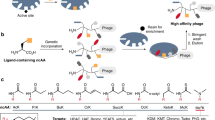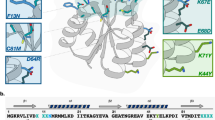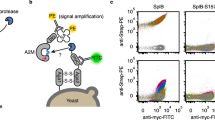Abstract
We describe a phage display methodology for engineering synthetic antigen binders (sABs) that recognize either the apo or the ligand-bound conformation of maltose-binding protein (MBP). sABs that preferentially recognize the maltose-bound form of MBP act as positive allosteric effectors by substantially increasing the affinity for maltose. A crystal structure of a sAB bound to the closed form of MBP reveals the basis for this allosteric effect. We show that sABs that recognize the bound form of MBP can rescue the function of a binding-deficient mutant by restoring its natural affinity for maltose. Furthermore, the sABs can enhance maltose binding in vivo, as they provide a growth advantage to bacteria under low-maltose conditions. The results demonstrate that structure-specific sABs can be engineered to dynamically control ligand-binding affinities by modulating the transition between different conformations.
This is a preview of subscription content, access via your institution
Access options
Subscribe to this journal
Receive 12 print issues and online access
$189.00 per year
only $15.75 per issue
Buy this article
- Purchase on Springer Link
- Instant access to full article PDF
Prices may be subject to local taxes which are calculated during checkout







Similar content being viewed by others
References
Murphy, P.M., Bolduc, J.M., Gallaher, J.L., Stoddard, B.L. & Baker, D. Alteration of enzyme specificity by computational loop remodeling and design. Proc. Natl. Acad. Sci. USA 106, 9215–9220 (2009).
Bowerman, N.A. et al. Engineering the binding properties of the T cell receptor:peptide:MHC ternary complex that governs T cell activity. Mol. Immunol. 46, 3000–3008 (2009).
Lowman, H.B. & Wells, J.A. Affinity maturation of human growth hormone by monovalent phage display. J. Mol. Biol. 234, 564–578 (1993).
Monod, J., Wyman, J. & Changeux, J.P. On the nature of allosteric transitions: a plausible model. J. Mol. Biol. 12, 88–118 (1965).
Koshland, D.E. Jr., Nemethy, G. & Filmer, D. Comparison of experimental binding data and theoretical models in proteins containing subunits. Biochemistry 5, 365–385 (1966).
Du, X. et al. Long range propagation of conformational changes in integrin α IIb β 3. J. Biol. Chem. 268, 23087–23092 (1993).
Kimura, T., Imai, Y. & Irimura, T. Calcium-dependent conformation of a mouse macrophage calcium-type lectin. Carbohydrate binding activity is stabilized by an antibody specific for a calcium-dependent epitope. J. Biol. Chem. 270, 16056–16062 (1995).
Medintz, I.L. & Deschamps, J.R. Maltose-binding protein: a versatile platform for prototyping biosensing. Curr. Opin. Biotechnol. 17, 17–27 (2006).
Oldham, M.L., Khare, D., Quiocho, F.A., Davidson, A.L. & Chen, J. Crystal structure of a catalytic intermediate of the maltose transporter. Nature 450, 515–521 (2007).
Oldham, M.L., Davidson, A.L. & Chen, J. Structural insights into ABC transporter mechanism. Curr. Opin. Struct. Biol. 18, 726–733 (2008).
Quiocho, F.A., Spurlino, J.C. & Rodseth, L.E. Extensive features of tight oligosaccharide binding revealed in high-resolution structures of the maltodextrin transport/chemosensory receptor. Structure 5, 997–1015 (1997).
Sharff, A.J., Rodseth, L.E., Spurlino, J.C. & Quiocho, F.A. Crystallographic evidence of a large ligand-induced hinge-twist motion between the two domains of the maltodextrin binding protein involved in active transport and chemotaxis. Biochemistry 31, 10657–10663 (1992).
Evenäs, J. et al. Ligand-induced structural changes to maltodextrin-binding protein as studied by solution NMR spectroscopy. J. Mol. Biol. 309, 961–974 (2001).
Rizk, S.S. et al. An engineered substance P variant for receptor-mediated delivery of synthetic antibodies into tumor cells. Proc. Natl. Acad. Sci. USA 106, 11011–11015 (2009).
Uysal, S. et al. Crystal structure of full-length KcsA in its closed conformation. Proc. Natl. Acad. Sci. USA 106, 6644–6649 (2009).
Ye, J.D. et al. Synthetic antibodies for specific recognition and crystallization of structured RNA. Proc. Natl. Acad. Sci. USA 105, 82–87 (2008).
Fellouse, F.A. et al. High-throughput generation of synthetic antibodies from highly functional minimalist phage-displayed libraries. J. Mol. Biol. 373, 924–940 (2007).
Marvin, J.S. et al. The rational design of allosteric interactions in a monomeric protein and its applications to the construction of biosensors. Proc. Natl. Acad. Sci. USA 94, 4366–4371 (1997).
de Lorimier, R.M. et al. Construction of a fluorescent biosensor family. Protein Sci. 11, 2655–2675 (2002).
Scatchard, G. The attractions of proteins for small molecules and ions. Ann. NY Acad. Sci. 51, 660–672 (1949).
Hammes, G.G. Thermodynamics and Kinetics for the Biological Sciences (Wiley, 2000).
Sharff, A.J., Rodseth, L.E. & Quiocho, F.A. Refined 1.8-Å structure reveals the mode of binding of β-cyclodextrin to the maltodextrin binding protein. Biochemistry 32, 10553–10559 (1993).
Koide, A., Gilbreth, R.N., Esaki, K., Tereshko, V. & Koide, S. High-affinity single-domain binding proteins with a binary-code interface. Proc. Natl. Acad. Sci. USA 104, 6632–6637 (2007).
Gould, A.D. & Shilton, B.H. Studies of the maltose transport system reveal a mechanism for coupling ATP hydrolysis to substrate translocation without direct recognition of substrate. J. Biol. Chem. 285, 11290–11296 (2010).
Gao, J., Sidhu, S.S. & Wells, J.A. Two-state selection of conformation-specific antibodies. Proc. Natl. Acad. Sci. USA 106, 3071–3076 (2009).
Otwinowski, Z. & Minor, W. Processing of X-ray diffraction data collected in oscillation mode. Methods Enzymol. 276, 307–326 (1997).
McCoy, A.J. et al. Phaser crystallographic software. J. Appl. Crystallogr. 40, 658–674 (2007).
Collaborative Computational Project, Number 4. The CCP4 suite: programs for protein crystallography. Acta Crystallogr. D Biol. Crystallogr. 50, 760–763 (1994).
Emsley, P., Lohkamp, B., Scott, W.G. & Cowtan, K. Features and development of Coot. Acta Crystallogr. D Biol. Crystallogr. 66, 486–501 (2010).
Murshudov, G.N., Vagin, A.A. & Dodson, E.J. Refinement of macromolecular structures by the maximum-likelihood method. Acta Crystallogr. D Biol. Crystallogr. 53, 240–255 (1997).
Painter, J. & Merritt, E.A. A molecular viewer for the analysis of TLS rigid-body motion in macromolecules. Acta Crystallogr. D Biol. Crystallogr. 61, 465–471 (2005).
Painter, J. & Merritt, E.A. Optimal description of a protein structure in terms of multiple groups undergoing TLS motion. Acta Crystallogr. D Biol. Crystallogr. 62, 439–450 (2006).
Winn, M.D., Isupov, M.N. & Murshudov, G.N. Use of TLS parameters to model anisotropic displacements in macromolecular refinement. Acta Crystallogr. D Biol. Crystallogr. 57, 122–133 (2001).
Lamzin,, V., Perrakis, A. & Wilson, K. The ARP/WARP suite for automated construction and refinement of protein models. in Crystallography of Biological Macromolecules, Vol. F (eds. Rossmann, M. & Arnold, E.) 720–722 (Kluwer Academic, 2001).
DeLano, W. The PyMOL Molecular Graphics System 0.99 edn (DeLano Scientific LLC, 2008).
Acknowledgements
This work was supported by US National Institutes of Health grants GM 072688 and F32DK080619-02 (to S.S.R.). Use of the Advanced Photon Source was supported by the US Department of Energy, Office of Science, Office of Basic Energy Sciences, under contract no. DE-AC02-06CH11357. Use of the LS-CAT Sector 21 was supported by the Michigan Economic Development Corporation and the Michigan Technology Tri-Corridor (grant 085P1000817). The authors thank A. Koide (University of Chicago) for providing the phage library.
Author information
Authors and Affiliations
Contributions
S.S.R. and A.A.K. designed the experiments and wrote the manuscript; S.S.R., M.P., J.H.H., E.M.D. and A.S. performed the experiments; E.M.D. solved the crystal structure.
Corresponding author
Ethics declarations
Competing interests
The authors declare no competing financial interests.
Supplementary information
Supplementary Text and Figures
Supplementary Figures 1 and 2 (PDF 180 kb)
Rights and permissions
About this article
Cite this article
Rizk, S., Paduch, M., Heithaus, J. et al. Allosteric control of ligand-binding affinity using engineered conformation-specific effector proteins. Nat Struct Mol Biol 18, 437–442 (2011). https://doi.org/10.1038/nsmb.2002
Received:
Accepted:
Published:
Issue Date:
DOI: https://doi.org/10.1038/nsmb.2002
This article is cited by
-
A conformation-selective monoclonal antibody against a small molecule-stabilised signalling-deficient form of TNF
Nature Communications (2021)
-
Human antibody-based chemically induced dimerizers for cell therapeutic applications
Nature Chemical Biology (2018)
-
Yeast surface display platform for rapid discovery of conformationally selective nanobodies
Nature Structural & Molecular Biology (2018)
-
Targeted rescue of cancer-associated IDH1 mutant activity using an engineered synthetic antibody
Scientific Reports (2017)
-
Conformational Change of a Tryptophan Residue in BtuF Facilitates Binding and Transport of Cobinamide by the Vitamin B12 Transporter BtuCD-F
Scientific Reports (2017)



